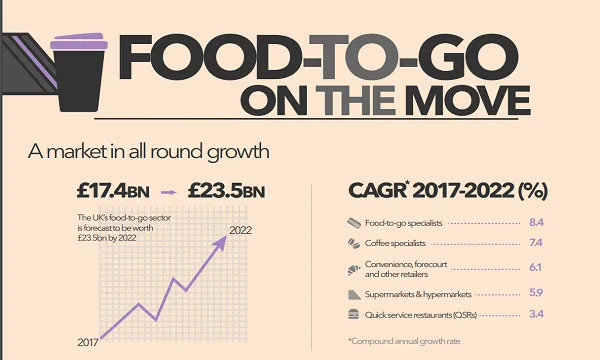
International Trends: The UK's food-to-go sector expected to be worth £23.5bn by 2022
Find out why food-to-go specialists will become the biggest part of the market.
The UK’s food-to-go sector is in rude health and will be worth £23.5bn by 2022, up from £17.4bn in 2017, according to the latest research from IGD.
IGD’s forecasts suggest there will be a particularly strong growth amongst specialist food-to-go retailers such as Greggs, Subway, Pret, EAT and Leon. They look set to overtake traditional QSRs to become the biggest sector of the market in the next five years.
IGD senior insight manager Gavin Rothwell said, “As shoppers become more sophisticated in their tastes and demands, so too does the UK’s food-to-go market. Across all our five market segments we’re seeing some highly innovative product and menu development, much of this inspired by shopper trends towards health and wellness and global flavours and tastes. Many operators are looking to tempt shoppers with ranges tailored to different times of day, while also improving the quality of their fresh food and coffee offers."
“Food-to-go specialists are really setting the pace on product innovation and range development, as well as expanding quite rapidly outside London, which is why we’re forecasting them to become the biggest part of the food-to-go market by the end of 2022. In addition to the well-known high street names, there are several new players emerging in this segment as well. Health and wellness is a particularly big focus for these specialists, with three-quarters (76%) of shoppers satisfied with the choice of healthy options available in-store, higher than any other segment of the food-to-go market," he added.
Rothwell said although he expects food-to-go specialists to become the biggest part of the market by 2022, QSRs are also set to grow well over the next five years, with 83% of the food-to-go shoppers who visit these stores satisfied with their overall experience. "Many QSR chains are updating their menus and reinventing the in-store experience to bring in more technology, creating a more premium look and feel to appeal to younger consumers. There are also many newer players emerging and expanding across the UK in this segment," he added.
IGD also noted the growing focus on food amongst coffee specialists, many of whom are now pushing the boundaries with menu upgrades and ranges tailored to different times of day, especially breakfast. Hot drinks remain the most purchased food-to-go product at breakfast, bought by half (49%) of shoppers, but over the last year there’s also been an overall rise in the number of products bought on a breakfast mission, including hot food (20%) and fruit (24%). There’s also a wave of smaller chains and niche independents innovating in this part of the market, all of which is encouraging larger coffee specialists to innovate with their own ranges, as well.
The report shows that convenience and forecourt retailers have spotted a great opportunity in the food-to-go market and are now becoming increasingly active in the area, either through their own ranges or by teaming up with well-known brand names to add credibility. Younger shoppers are particularly likely to drive growth in these stores, with 18-25-year-olds twice as likely to buy food-to-go in convenience stores compared to their older counterparts.
The same goes for supermarkets and hypermarkets, which are increasingly devoting more space in-store to food-to-go. Many are expanding their own ranges as well as creating new partnerships with suppliers to introduce more diverse in-store experiences, such as sushi bars and juice bars. With over half (55%) of food-to-go shoppers visiting a supermarket, opportunity for these stores to perform well in food-to-go is plenty.
“For both food-to-go operators and suppliers, there’s plenty to play for,” added Rothwell. “In future, we expect to see the five market segments we’ve identified become increasingly blurred, as specialists and grocery retailers continue to combine great fresh food-to-go ranges with excellent drinks offers that tick the boxes for shoppers when it comes to quality."
"It’s common for shoppers to visit more than one store to complete their food-to-go shop, especially at breakfast (53%) but also throughout the day. Suppliers to the food-to-go sector therefore have a great opportunity to work closely with retailers and specialists to create winning ranges that will ultimately meet more shoppers’ needs, making their lives easier,” he concluded.
























